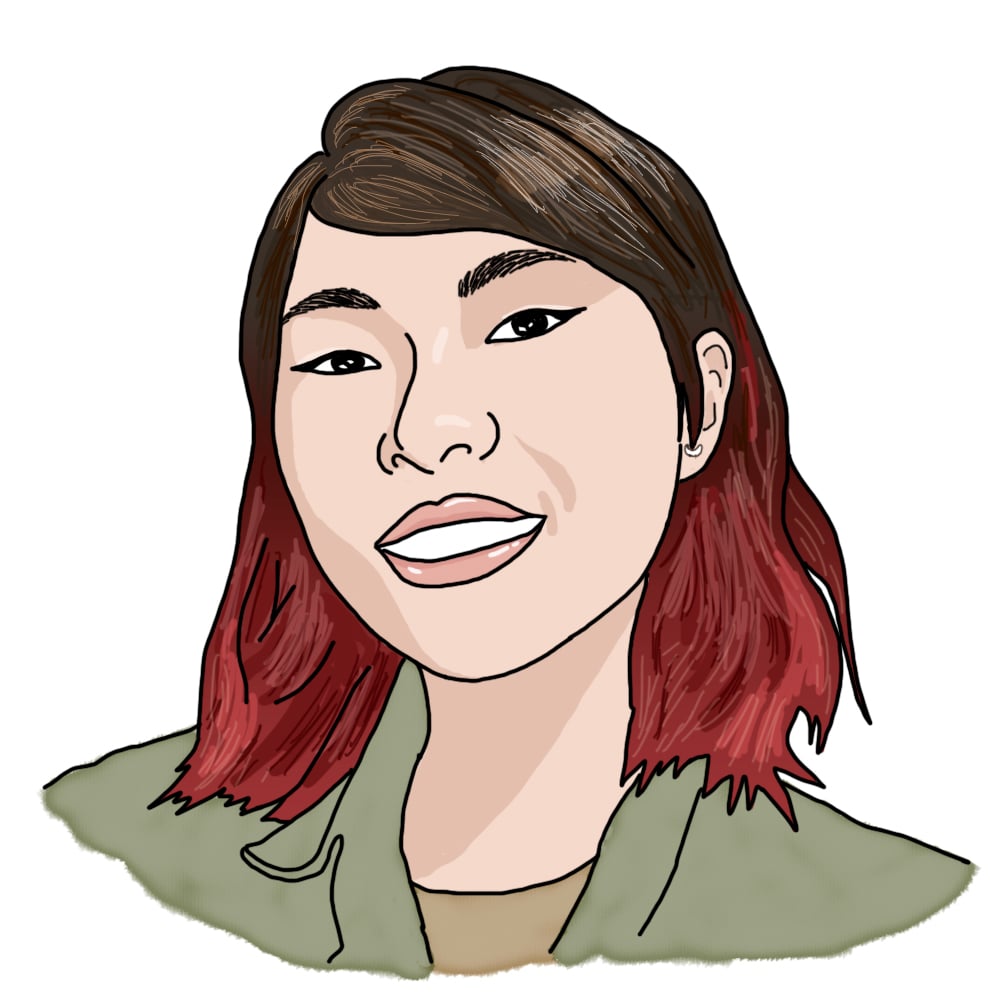
learning about Things!! by Audrey C. '24
cool classes explained in easy words
After three and a half years of being at this school, I’ve taken quite a few classes. What have I even learned from them? I’m bad at remembering numbers (sometimes I forget my own phone number), but there were definitely cool ideas from my classes that have stuck with me. I also got to meet cool people through classes, who have pushed me to think in new ways. I know it’s easier to talk about liking a class when it’s over, but some classes I remember were fun even while I was taking them.
6.UAT01 obviously class numbers are not in the ten hundred most used words, but I'm leaving them in to make searching for the actual classes easier if anyone wants to know what they're actually about How to Talk Better So People Listen More
We gave a lot of talks to get better at sharing our work in such a way that other people can easily understand and find interesting. Part of it is in how we explain things, like using too many hard words will make people lost. But explaining big ideas like you’re telling a story will make people care more and understand better. Another part of it is in how we talk — being excited when you talk, speaking loud and clear, not talking too quickly, can all add to your story. I often fear that when I talk, people aren’t actually listening, so I’m glad that there are real steps I can take to make people listen more.
2.678 How to Power Things to Make Things Happen Part 1
There are really small things that carry power over time. We can build small roads to control how these really small things move. These roads can also have parts that make less of the really small things move over time, can store and let go of [power over time], or change where the really small things are going. Building roads with the right parts is how we can use [power over time] to turn on lights, make things move, and make computers think and do things. I really liked the class when I took it, and last fall I got to help run the class!02 why is 'teach' not in the ten hundred most common words??!
2.679 How to Power Things to Make Things Happen Part 2
This class builds off of How to Power Things to Make it Work Part 1, showing us more ways to build roads for really small things and more parts to add in the roads. Sometimes you need the really small things to carry power in ways that repeat or change over time. We learned how to use small computers to control how power is carried (and how to use power to control small computers) in Part 1, so Part 2 showed us more ways to do both! We also learned how to use computers to lay out roads that can be made again and again.
(I’m sorry if it hurt your brain to read about 2.678/2.679. I promise they are really good classes that I learned a lot from, but up goer five was not having it with so many of the important words used in these classes.)
6.115 Even More Cool Things About Small Computers
It turns out that small computers are made out of… smaller computers!! In these smaller computers there might be even smaller computers, but eventually you get down to small roads that carry really small things (as talked about in How to Power Things to Make Things Happen). This class looks at how the really small things can carry “words” that small computers can understand in the form of bits, and how smaller computers come together to carry out everything a small computer needs to be able to do (such as read, write, and store bits). If something isn’t working, you may look at the bits being written or read to see what’s going wrong. This class ate up SO much of my time, but understanding how exactly small computers work and how to fix things that aren’t working really opens up the world of building things that use power.
2.007 How to Build a Thing that Moves
This class was all about building a thing that we can drive to move! We need to make all of the different parts for the thing, put all the different parts together, power the thing, and (maybe) show that you can drive your thing better than everyone else. I learned so many different ways to make parts! I also learned the hard way that if you don’t think hard enough about the way you make the parts, it can be hard to put them together. Just because the thing works once doesn’t mean it will work again, so it was important to build the thing so that it can work again and again. But of course as it always goes, my thing decided to suddenly not work when it really mattered. Still, this class was so fun!
2.008 How to Make A Thing Many Many Times
In How to Build a Thing that Moves, we only had to build one of the thing. But if you want to make money from building things, it’s often important to make tens of hundreds of the same thing that all work the way you want it to! We really had to think about how each step of making a thing can be easily repeated. At the end of the class, we had to make five tens of a small thing that turns. If one of the steps to making the thing takes a bit more work, that “bit more work” adds up to be a lot of work if you have to repeat it five ten times.
2.737 How to Control a Thing that Moves
When you make a thing that moves, you may also need to think about how to make it move exactly how you want it to — this is called controls. This class focused on the type of controls where you look at how far off your thing is from where you want it to be. If your thing is very off, your thing should move a lot. But if your thing is pretty close, it only needs to move a little bit. You would use computers to decide how much to move the thing, but computers are never perfect at understanding how a real life thing moves. Sometimes not being perfect doesn’t matter, but other times it will throw your controls off and your thing won’t move at all how you want it to. In this class, we learned a lot about when it does matter for your computer’s understanding of the real life thing to be as close to perfect as possible.
6.8210 How to Control a Thing When You Don’t Know How Exactly It Should Move
Sometimes, especially if you want to build a thing that walks or does a back flip, you might not know how exactly to make that happen. Where should the thing move its leg and by how much? How should we consider all the ways the other legs can move? You can use a computer to figure out that out! You will need to tell a computer what it means to move in the best way (like maybe using as little power as possible, or landing on its feet as easily as possible, or both), and then the computer can find that best way.
9.53 Why Brains Are Better than Computers
Computers can do so many things so quickly, so sometimes we over look how cool brains are too. Babies only need to see a few pictures of a cat to know what a cat is, but computers need tens of hundreds of cat pictures to learn that a cat is not a dog. A computer eats up the power used by Ice Land in a year to learn how to speak, way more power than what babies eat in a year. And babies learn how to speak all the same. With computers, you can look at bits to understand how the computer as a whole works. But you can’t just look at the small things that make up brains to understand why we walk, talk, think, and do all the cool things that we do so much more easily than computers. In this class, we looked at both computers and brains through this idea that maybe you don’t want to understand a big thing by looking at the small things by themselves, but instead through the way that smaller things can cause big changes when they work together.
9.85 How do Babies Learn Things
With babies, it might seem like there is not a single thought behind those eyes. But babies know way more than what you might expect! Babies learn how to talk when they are one year old, but there are ways to understand what younger babies are thinking even if they can’t say it yet. If a baby is surprised at something, they will look at it for longer. So if a baby is looking at something for longer, then you know that it’s not what the baby thought would happen. Then you can reason what the baby did think would happen. By understanding what babies know and how they think as they get older, we can then piece together how babies learn starting from the moment they are put into this world.
21W.762 Writing Words That are Beautiful
This was by far the most relaxing class I’ve taken at this school! Every class we would read our beautiful writing out loud one by one, and then everyone else would comment with what they thought about it. We did talk about forms, but it didn’t really matter if we followed them as long as we wrote something. I thought a lot about how to put words together in ways that were interesting, song-like, or not expected — it’s fun thinking about writing as an art.
21W.744 Writing for Picture Stories
I love picture stories!! Usually you’ll need to write the story before you add the drawing part, and this class focused on the writing. We really thought about how writing can be used to build the world the stories live in, drive the story forward, and make the people in the stories interesting. Stories only move forward if there is a reason for people to be mad at the world, at each other, or at their own self. It’s fun to write about people being mad at something, as it makes you figure out why the story world and the people living in it are the way they are.
21L.480 Reading Stories About People Who Are “Happy”
We read stories about girls who like girls, boys who like boys, people who are not boys or girls (who can like people too), about people who the world sees as different. These stories tell us why the world sees some people as different and how who we are, in all the different ways we can be, colors how we live. There can be pain that comes with the world seeing you as different, but people find ways to be happy as themselves anyways. And telling stories is an important part of that.

something I painted, thinking about a Beautiful Writing we read in 21L.480 :)
- obviously class numbers are not in the ten hundred most used words, but I'm leaving them in to make searching for the actual classes easier if anyone wants to know what they're actually about back to text ↑
- why is 'teach' not in the ten hundred most common words??! back to text ↑